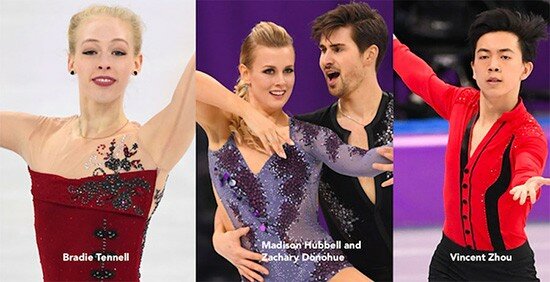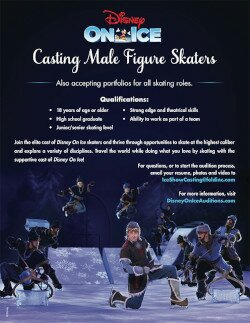 (©No reproduction, translation or re-posting on third party websites is permitted)
(©No reproduction, translation or re-posting on third party websites is permitted)
The 2017-2018 season was a mixed bag for Team USA. Though there were some bright spots along the way, it was the kind of year an American team would expect from a post-Olympic rebuilding season, not one in prime time.
The ice dancers continued to lead the U.S. contingent on the international stages and show no signs of ceding that status, but in the other three disciplines, Team USA could use some help.
The American ladies seemed unprepared from the moment last season began and it was immediately evident they would not be in contention for medals at the 2018 Olympic Winter Games or the World Championships.
Ashley Wagner was unable to regain the form that propelled her to her only World podium in 2016, and faded as the season progressed. Whether it was nerves or a lack of commitment to training, Wagner just could not overcome her curse of fourth- place finishes at the U.S. Championships in Olympic years and failed to make the 2018 squad, leaving the American ladies without a solid leader heading into PyeongChang.
Instead, it was a relative unknown, Bradie Tennell, who rose to the top. A steely competitor with a penchant for consistency, Tennell would have been better served to play the bridesmaid in her first year of senior international competition.
Though she did well to manage the bright lights of the Olympic Games, Tennell placed ninth in PyeongChang — the lowest finish by a U.S. ladies champion in history. She improved to sixth place at the World Championships a month later, but Tennell still has a long way to go to compete with the best ladies in the world.
Mirai Nagasu was a bright spot in the Team Event in PyeongChang, nailing a triple Axel in the free skate, but in her individual competition she seemed tired and lacked focus. At the World Championships, Nagasu equaled her 10th-place finish at the Olympics. With her attention now shifted (i.e. “Dancing With the Stars: Athletes Edition”), it is unknown if Nagasu will make another go of it on competitive ice.
The third Olympic team member, Karen Chen, should have been a lock for a spot on the team, but her frantic fall season put that into question. Not only was the 2017 U.S. champion unable to settle on what programs to skate until late in the season, her claim of boot issues persisted. Making the team by the skin of her teeth, Chen threw away a chance at a medal through indecisiveness and second-guessing.
Looking to the next generation, Ting Cui, 16, seems to be a strong contender to challenge for a podium spot at the 2019 U.S. Championships and beyond. She is capable of executing world-class technical content and is becoming a strong competitor. Though too young for senior internationals until 2022, Alysa Liu, the 2018 U.S. junior champion, could be the answer to U.S. Figure Skating’s prayers. She is a fearless competitor who is already tackling triple Axel combinations in practice.
The men fared somewhat better in PyeongChang — fifth, sixth and 10th — but still fell short of pre-event expectations. Nathan Chen took himself out of contention with a disastrous short program that left him in 17th place. Despite winning the free skate, Chen could not overcome the deficit and finished fifth. He redeemed himself at Worlds, capturing the title by nearly 50 points over injured silver medalist Shoma Uno of Japan.
Vincent Zhou blew hot and cold throughout the season, mainly due to questionable landings on his quad jumps. The technical panel was lenient in PyeongChang and Zhou racked up the points to finish in sixth place. However, a stricter panel at Worlds hammered him with under-rotation and downgrade calls. He finished 14th in Milan.
Adam Rippon ranked a respectable 10th at the Olympic Games, but given his age and his newfound celebrity status, it is highly unlikely he will be in the mix going forward.
Beyond the top tier of American men, there is a handful of up-and-comers who showed potential last season. Three men qualified for the Junior Grand Prix Final, which Alexey Krasnozhon won. If not for his unfortunate accident at the World Junior Championships, it is possible that Team USA would have claimed both the junior and senior World titles in the same season.
The ice dancers were the feather in American skating’s cap, winning medals at all six senior Grand Prix events and four on the Junior Grand Prix circuit. Three teams qualified for the senior Grand Prix Final for a third consecutive season, while 2018 U.S. junior champions Christina Carreira and Anthony Ponomarenko won silver in their second trip to the junior Final.
Maia and Alex Shibutani continued a string of podium finishes for American ice dancers at the Olympic Winter Games dating back to 2006, and Madison Hubbell and Zachary Donohue’s silver at the World Championships was the 11th year in the last 13 that a U.S. team had won a medal at the global event.
A bumper crop of young teams will fight it out to fill the void left by the one-year hiatus of the Shibutanis. Though not as seasoned, Team USA boasts three teams from the World Junior Championships that will likely begin to challenge for international medals in the next quadrennial.
American pairs continued their downward spiral on the international scene last season, with U.S. champions Alexa Scimeca Knierim and Chris Knierim finishing in a dismal 15th place at both the 2018 Olympic Winter Games and the subsequent World Championships.
Last season, no U.S. pairs team stood on a Grand Prix podium (junior or senior) and just two medals were won during the Challenger Series. Tarah Kayne and Danny O’Shea won the 2018 Four Continents title in a depleted field in late January, but withdrew from the World Championships citing injury.
Ashley Cain and Timothy LeDuc also seem poised to make a move up the ladder after capturing the silver medal at Four Continents in just their second season together.
The U.S. junior champions, Audrey Lu and Misha Mitrofanov, have shown great promise, finishing fifth at 2018 World Juniors with the highest score of a U.S. team in the event’s history.
But the problems at the center of American pairs skating remain. Most of the teams focus on doing the elements and pushing the technical envelope with quadruple twists and throws, but forget about the basics. In comparison with the top international teams, the U.S. falls short in terms of cleanliness and fails to capture the extra grade of execution points. A quick fix is not going to happen here and unless the top teams start focusing on quality instead of quantity, the results will continue to be disappointing.
DEVELOPMENT PLAN
Justin Dillon, the director of high performance development for U.S. Figure Skating, is charged with identifying and growing the next generation of champions. In his role, Dillon has identified one trend that is redefining the sport — youth. “Specifically in ladies singles, we have a very young trend going on,” he said. “The World Junior champion is 13 years old with two quads and the Olympic champion is 15. We definitely see this generation of skaters having success at a younger age.”
With that trend in mind, Dillon revealed some of the key initiatives that U.S. Figure Skating is hoping will improve athlete performance and, in turn, create better placements over the next four years. “One of the things we are working on is getting athletes through the competitive structure sooner,” he said. “U.S. Figure Skating offers more levels than many other federations in the world (eight in total), and one of the things that we tackled at this summer’s Governing Council was to look at our competition structure — to offer development opportunities for those athletes at the lower levels and make nationals really about junior and senior.”
Dillon refers to the 2018 Governing Council, an annual meeting for the organization that serves to vote on changes to existing rules within the national structure, among other things. This year a proposal was made to limit the U.S. Championships to the senior and junior levels, with the novice, intermediate, and juvenile competitors ending their domestic season at the sectional level. “I think we spend a lot of time trying to win national titles in the U.S. at the lower levels because it’s a great achievement to be the best skater in our country,” he said.
“But right now the best skaters in our country are not the best skaters in the world. Our ladies were ninth, 10th, and 11th at the Olympics, so we need to create an environment where those ladies are pushing towards the podium. We’ll try to get these athletes through the levels faster so that they are at the junior and senior levels at a younger age.”
Dillon has a development plan for skaters at the novice level and below. “The top two from each section in novice singles would get invited to compete at the U.S. Championships at the junior level,” he explained. “We would have a training summit or camp for those that would have (previously) qualified for nationals, but rather than spend all that money for one competition, they will come together to train for a number of days, have that head- to-head experience, and receive training opportunities with officials who will provide feedback to help them grow into stronger competitors. At this camp we will be looking at talent identification. This will allow us to get them the development opportunities they need, and get them competing internationally sooner.”
The way in which the World Junior Championships teams will be selected will also be revamped for the 2018-2019 season. “This year our intent is have our entire team named at the World Junior camp,” Dillon said. “We will look at this person’s entire season and see how competitive they can be at the right time. At the end of the two-day camp, you will have your named team and ranked alternates.”
U.S. Figure Skating will also have a jump camp for the second year, bringing together some of the top coaches across the country with more than 100 athletes to focus on all things jumping.
The organization once again invited Russia’s Nina Mozer and her coaching team to work with American pairs teams at a camp in early June. “Detail is the most important piece to improvement in our pairs program. We look at the Russian pairs teams in their side-by-side spins and footwork, and they are racking up so many points in grades of execution,” Dillon explained.
“I listened to (Mozer) at our seminar last year and she was about the toe point, the detail, the exit — everything is so refined that it’s a well-oiled machine. From physique to strength training to the spin on the ice, they look at every single detail. They are not just teaching them a skill and then saying, ‘that’s good enough.’”
But no matter what U.S. Figure Skating does to grow young talent, Dillon sees the top skaters being strong influencers of future success. “We need to continue to cater to our top talent at the senior level, while simultaneously fostering our younger talent so that we continue to build for the future,” he said. “The top skaters can be role models for the next generation and influence them to reach new heights. But when they continually finish in the eighth, ninth and 10th range, it’s hard for the younger ones to see that there is a pathway to the top. So, we really have to take care of the top.
“It’s a new quadrennial, so if we are going to do anything revolutionary or crusader-like, now is the time to do it. That is why we are going to take a stab at these initiatives and see how it goes.
“If it works, great, and if not, then we’ll go back to the drawing board.”
(Originally published in the IFS May/June 2018 Issue )





